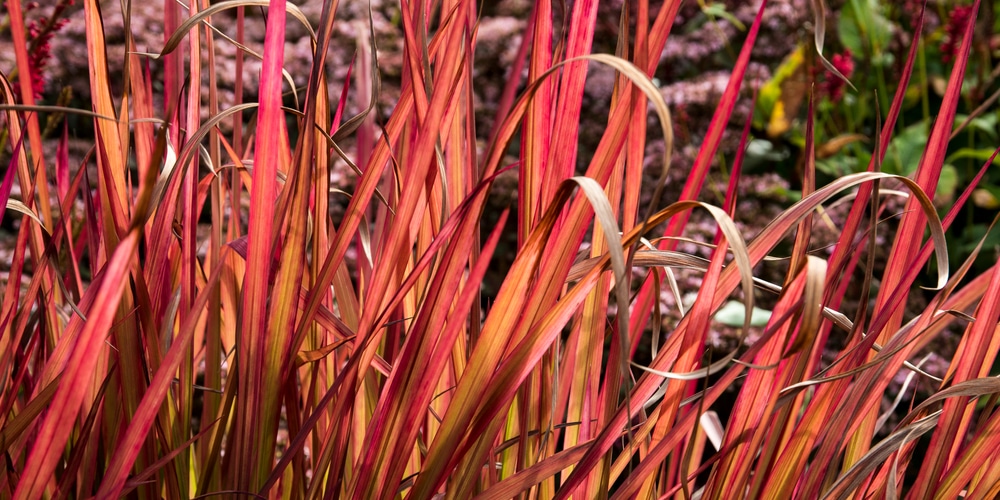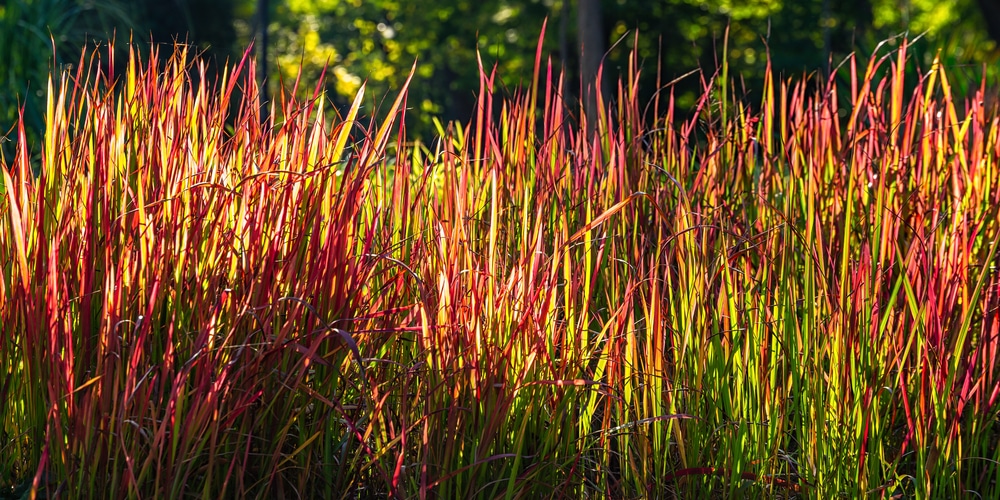When it comes to ornamental grasses, Japanese blood grass is one of the most unique and interesting varieties.
This perennial grass is native to Japan, China, and Korea and gets its name from the crimson color of its leaves. With its tips illuminating in a beautiful shade of red, Japanese blood grass is truly a sight to behold.
It can be used as a border plant, groundcover, or even as an accent in containers. Its red-tipped leaves add a splash of color to the garden, and it’s a perfect plant for adding fall interest.
Japanese blood grass is not only beautiful, but it’s also relatively easy to care for. In this article, we’ll go over everything you need to know about Japanese blood grass care, including how to plant, grow, and take care of this stunning plant.
| Botanical Name | Imperata Cylindrical |
| Common Name | Cogongrass or Japanese Blood Grass |
| Plant Type | Perennial |
| Flower Color | White; mall and inconspicuous |
| Size When Mature | 12-24 inches |
| Bloom Time | Late Summer |
| Sun Requirements | Full sun; can tolerate partial shade |
| USDA Hardiness Zones | 5-9 |
| Soil PH Range | 6.5-7.5 |
| Soil Type | Moist, well-draining, acidic |
| Water Needs | Medium |
| Native Area | Japan, Korea, and other Asian countries |
What You Need to Know About Japanese Blood Grass
Despite its name, Japanese blood grass is not actually related to true grasses. It is a member of the Poaceae family, but it has a more delicate appearance, with slender stems and fine leaves. Its leaves are thin and linear, arranged in a spiral pattern around the stem. This plant is definitely a showstopper with a bright-colored body and crimson red tips.
This refreshing-looking plant is native to Asia, and it has been introduced to gardens around the world. In its native habitat, Japanese blood grass grows in open meadows and moist woods.
Japanese blood grass is a perennial plant that typically grows to be about one to two feet tall (12-24 inches) once it matures. The flowers of this plant are small and inconspicuous, and they grow in clusters at the tips of the stems.
How to Care for Japanese Blood Grass
Japanese blood grass is a relatively low-maintenance plant, and it’s easy to care for once you know the basics. Here’s everything you need to know about growing and caring for a thriving Japanese blood grass.
Light
Japanese blood grass is a beautiful, tropical plant that requires specific growing conditions to thrive. In general, its colors are more vibrant when exposed to at least 6 hours of full sun a day, but it can also tolerate partial shade in some Southern areas.
If you live in an area with hot summers, it’s best to provide some afternoon shade to protect your plant from the intense heat.
Japanese blood grass is a delicate plant, and too much direct sunlight can cause the leaves to scorch. If you notice your plant’s leaves turning yellow or brown, it’s a sign that it’s getting too much sun.
An afternoon shade cloth can help protect your plant from the harsh afternoon sun and prevent leaf scorching.
Water and Soil Needs
Japanese blood grass is a moisture-loving plant, and it requires regular watering to stay healthy. During the growing season (spring and summer), Japanese blood grass should be watered weekly or more often if the weather is hot and dry.
Ideally, giving it a deep soak several times per week is best. It thrives in moist soil that’s acidic and well-draining.
During the winter months, Japanese blood grass goes dormant and doesn’t need as much water. Once a month should be sufficient. When watering this plant, be sure to check the soil first.
If it’s moist, you don’t need to water it. Over-watering is one of the most common mistakes people make when caring for Japanese blood grass, so it’s essential to be mindful of the plant’s water needs.
Temperature Requirements
Japanese blood grass is best suited for USDA climate zones 5 through 9, where temperatures are relatively mild. This plant can tolerate cold winters and hot summers, but it does not do well in extreme temperatures. If you live in an area with very cold winters, growing Japanese blood grass in your backyard may pose a challenge.
For optimum growth and development, Japanese blood grass prefers daytime temperatures between 70 and 80 degrees Fahrenheit, and nighttime temperatures about 15 degrees cooler. If you live in an area with hot summers, it’s best to provide some afternoon shade to protect your plant from the intense heat.
Fertilizer
Unlike other plants, Japanese blood grass doesn’t require a lot of fertilizer to stay healthy. In fact, as a fast-growing plant, too much fertilizer and extra nutrients may result in the plant’s aggressive growth habit and make it difficult to control.
If you decide to fertilize your Japanese blood grass, use a balanced, all-purpose fertilizer diluted to half-strength. Fertilize the plant every other month during the growing season (spring and summer), and skip fertilizer altogether during the winter months when the plant is dormant.
Common Diseases
Caring for Japanese blood grass can be a bit of a challenge, as this unique plant is prone to a number of common diseases.
The first thing you should be aware of when growing blood grass is that it is particularly susceptible to rot and mildew. Rot usually occurs in areas where there is too much moisture, either from heavy rain or poor drainage.
Meanwhile, mildew is typically caused by excess humidity and tends to develop on the leaves and stems of plants. Because these two diseases tend to go hand in hand, it’s important to monitor your blood grass for signs of rot and mildew regularly and take steps to prevent them from occurring.
On the other hand, Japanese blood grass is fairly pest-resistant. These plants are not often bothered by common garden pests, such as aphids, caterpillars, or slugs. They are also rabbit and deer resistant, which is good news for those who live in areas where these animals are often sighted.
Japanese Blood Grass Propagation
Japanese blood grass is a fantastically versatile plant that can thrive in a wide range of conditions. With its long, sword-like leaves and beautiful red blooms, this versatile plant is sure to add interest and color to any garden.
Division is the most common propagation method, as it’s relatively easy to do and doesn’t require any special equipment.
To divide Japanese blood grass, simply dig up the plant in early spring and carefully separate the root ball into smaller sections. Each section should have at least one bud or “eye.”
Replant the divisions immediately, making sure to water them well. This technique works best if the plant has fully established itself in the ground but has grown large enough to be divided.
Don’t worry about cutting these plants. They mature and grow quickly, and they’ll rapidly bounce back without you noticing it.
You can also propagate blood grass by seed, but this method is more challenging and takes longer to produce results.
Japanese Blood Grass: Final Thoughts
Japanese blood grass is a beautiful, ornamental grass that is perfect for adding a touch of color to any garden. The bright green blades offset the deep red leaves, and the plant is relatively easy to care for.
However, Japanese blood grass can be invasive, and it spreads quickly. If not carefully managed, it can quickly take over a garden. But with a bit of attention, Japanese blood grass can be a beautiful addition to any landscape.
You may also like: 10 Flowers That Start with the Letter B


